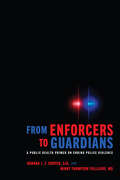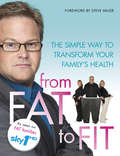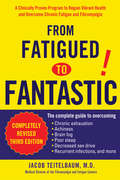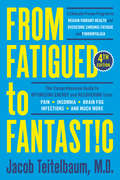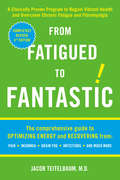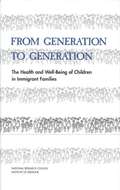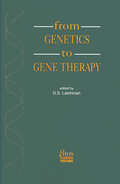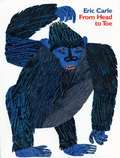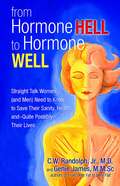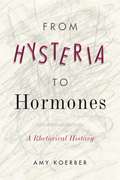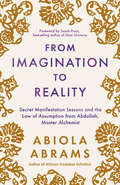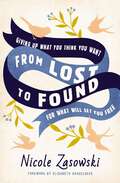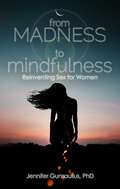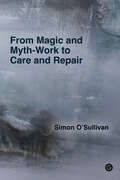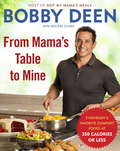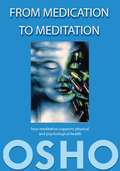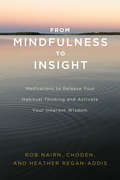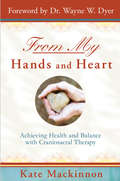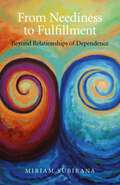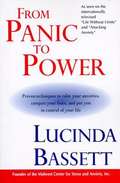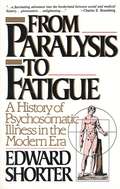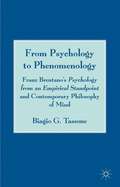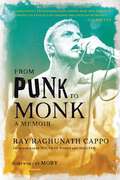- Table View
- List View
From Enforcers to Guardians: A Public Health Primer on Ending Police Violence
by Mindy Thompson Fullilove Hannah L. CooperA public health approach to understanding and eliminating excessive police violence.Excessive police violence and its disproportionate targeting of minority communities has existed in the United States since police forces first formed in the colonial period. A personal tragedy for its victims, for the people who love them, and for their broader communities, excessive police violence is also a profound violation of human and civil rights.Most public discourse about excessive police violence focuses, understandably, on the horrors of civilian deaths. In From Enforcers to Guardians, Hannah L. F. Cooper and Mindy Thompson Fullilove approach the issue from a radically different angle: as a public health problem. By using a public health framing, this book challenges readers to recognize that the suffering created by excessive police violence extends far outside of death to include sexual, psychological, neglectful, and nonfatal physical violence as well.Arguing that excessive police violence has been deliberately used to marginalize working-class and minority communities, Cooper and Fullilove describe what we know about the history, distribution, and health impacts of police violence, from slave patrols in colonial times to war on drugs policing in the present-day United States. Finally, the book surveys efforts, including Barack Obama's 2015 creation of the Task Force on 21st Century Policing, to eliminate police violence, and proposes a multisystem, multilevel strategy to end marginality and police violence and to achieve guardian policing. Aimed at anyone seeking to understand the causes and distributions of excessive police violence—and to develop interventions to end it—From Enforcers to Guardians frames excessive police violence so that it can be understood, researched, and taught about through a public health lens.
From Fat to Fit
by Sally MorrisDo you want to improve your family's health and fitness for good?Hit TV show Fat Families has shrunk the waistlines of some of the nation's fattest families with its simple strategies and no-nonsense attitude. Now you can transform your family's health with this fat-busting plan.Combining the wisdom from the show's top diet and fitness experts with the real-life stories of the fat families turne thin, From Fat to Fit sets out a clear, easy and safe plan for the whole family to lose weight permanently.Includes:- Simple recipes and meal plans to revolutionise meal times- Easy lifestyle changes to get the whole family moving- Top tips and tricks from the show's families to stay on track - How to treat yourself at parties, on holiday and eating out - and still lose weight!Diet together and help each other turn from fat to fit!
From Fatigued to Fantastic
by Jacob TeitelbaumThe original, bestselling guide to treating chronic fatigue and fibromyalgia-now completely revised and updated. For the more than twenty-five million Americans who suffer from chronic fatigue, fibromyalgia, and other fatigue-related illnesses, there is only one bestselling guide-From Fatigued to Fantastic. This new, completely updated third edition incorporates the latest advances in science and technology to help alleviate the baffling, often dismissed symptoms associated with severe, almost unrelenting fatigue. Dr. Teitelbaum's integrated treatment program is based on the clinically proven results of his landmark study and on his more than thirty years of experience in working with patients to overcome their illnesses. Using the most current information, Dr. Teitelbaum helps his readers evaluate their symptoms and develop an individualized program to eliminate them. Specific guidelines for diagnosis and care are clearly and concisely presented, along with supporting scientific studies and treatment recommendations that include the latest and best strategies for using prescription and over-the-counter medications, nutritional supplements, alternative therapies, and/or dietary and lifestyle modifications. In addition to providing cutting-edge research, up-to-date scientific information, and practical advice, Dr. Teitelbaum offers the compassionate understanding of one who has himself battled and overcome these disorders.
From Fatigued to Fantastic
by Jacob TeitelbaumThe original, bestselling guide to treating chronic fatigue and fibromyalgia-now completely revised and updated. For the more than twenty-five million Americans who suffer from chronic fatigue, fibromyalgia, and other fatigue-related illnesses, there is only one bestselling guide-From Fatigued to Fantastic. This new, completely updated third edition incorporates the latest advances in science and technology to help alleviate the baffling, often dismissed symptoms associated with severe, almost unrelenting fatigue. Dr. Teitelbaum's integrated treatment program is based on the clinically proven results of his landmark study and on his more than thirty years of experience in working with patients to overcome their illnesses. Using the most current information, Dr. Teitelbaum helps his readers evaluate their symptoms and develop an individualized program to eliminate them. Specific guidelines for diagnosis and care are clearly and concisely presented, along with supporting scientific studies and treatment recommendations that include the latest and best strategies for using prescription and over-the-counter medications, nutritional supplements, alternative therapies, and/or dietary and lifestyle modifications. In addition to providing cutting-edge research, up-to-date scientific information, and practical advice, Dr. Teitelbaum offers the compassionate understanding of one who has himself battled and overcome these disorders.
From Fatigued to Fantastic
by Jacob TeitelbaumThe original, bestselling guide to treating chronic fatigue and fibromyalgia-now completely revised and updated. For the more than twenty-five million Americans who suffer from chronic fatigue, fibromyalgia, and other fatigue-related illnesses, there is only one bestselling guide-From Fatigued to Fantastic. This new, completely updated third edition incorporates the latest advances in science and technology to help alleviate the baffling, often dismissed symptoms associated with severe, almost unrelenting fatigue. Dr. Teitelbaum's integrated treatment program is based on the clinically proven results of his landmark study and on his more than thirty years of experience in working with patients to overcome their illnesses. Using the most current information, Dr. Teitelbaum helps his readers evaluate their symptoms and develop an individualized program to eliminate them. Specific guidelines for diagnosis and care are clearly and concisely presented, along with supporting scientific studies and treatment recommendations that include the latest and best strategies for using prescription and over-the-counter medications, nutritional supplements, alternative therapies, and/or dietary and lifestyle modifications. In addition to providing cutting-edge research, up-to-date scientific information, and practical advice, Dr. Teitelbaum offers the compassionate understanding of one who has himself battled and overcome these disorders.
From Fatigued to Fantastic! Fourth Edition: A Clinically Proven Program to Regain Vibrant Health and Overcome Chronic Fatigue
by Jacob Teitelbaum"Dr. Teitelbaum has updated his pioneering and groundbreaking book From Fatigued to Fantastic, and this classical volume is a must-read for anyone suffering from chronic fatigue syndrome or fibromyalgia--and for their loved ones and friends as well."--Neil Nathan, M.D. author of Toxic: Heal Your Body from Mold Toxicity, Lyme Disease, Multiple Chemical Sensitivities, and Chronic Environmental IllnessThe original, bestselling guide to treating chronic fatigue and fibromyalgia-now completely revised and updated.25 million Americans suffer needlessly from fatigue, pain, chronic fatigue syndrome (CFS), and fibromyalgia (FMS). The good news is: we don't have to.This long-awaited updated edition of From Fatigued to Fantastic! includes the most up-to-date information, as well as state-of-the-art protocols and treatment plans that you can implement on your own or with the help of your physician. The answers are in your hands, with clearly organized, easy-to-read information from one of the world's premier researchers in the field of CFS and FMS. Finally, the most current and reliable source for those suffering from chronic fatigue and pain is here and ready to make your life better.Are you ready to feel fantastic?
From Fatigued to Fantastic!: A Clinically Proven Program to Regain Vibrant Health and Overcome Chronic Fatigue
by Jacob Teitelbaum&“Dr. Teitelbaum has updated his pioneering and groundbreaking book From Fatigued to Fantastic, and this classical volume is a must-read for anyone suffering from chronic fatigue syndrome or fibromyalgia—and for their loved ones and friends as well.&”—Neil Nathan, M.D. author of Toxic: Heal Your Body from Mold Toxicity, Lyme Disease, Multiple Chemical Sensitivities, and Chronic Environmental Illness 25 million Americans suffer needlessly from fatigue, pain, chronic fatigue syndrome (CFS), and fibromyalgia (FMS). The good news is: we don&’t have to.This long-awaited updated edition of From Fatigued to Fantastic! includes the most up-to-date information, as well as state-of-the-art protocols and treatment plans that you can implement on your own or with the help of your physician. The answers are in your hands, with clearly organized, easy-to-read information from one of the world&’s premier researchers in the field of CFS and FMS. Finally, the most current and reliable source for those suffering from chronic fatigue and pain is here and ready to make your life better.Are you ready to feel fantastic?
From Generation to Generation: The Health and Well-Being of Children in Immigrant Families
by Committee on the Health Adjustment of Immigrant FamiliesImmigrant children and youth are the fastest growing segment of the U.S. population, and so their prospects bear heavily on the well-being of the country. However, relevant public policy is shaped less by informed discussion than by politicized contention over welfare reform and immigration limits.From Generation to Generation explores what we know about the development of white, black, Hispanic, and Asian children and youth from numerous countries of origin. Describing the status of immigrant children and youth as "severely understudied," the committee both draws on and supplements existing research to characterize the current status and outlook of immigrant children.The book discusses the many factors--family size, fluency in English, parent employment, acculturation, delivery of health and social services, and public policies--that shape the outlook for the lives of these children and youth. The committee makes recommendations for improved research and data collection designed to advance knowledge about these children and, as a result, their visibility in current policy debates.
From Genetics to Gene Therapy: The Molecular Pathology of Human Disease
by David S. LatchmanDistinguished scientists provide an overview of the molecular pathology of human disease. Each chapter provides an analysis of the molecular biological approaches to individual diseases, such as leukaemia, cardiovascular disease and cancer. To celebrate the formation of the new Department a I-day meeting entitled 'From Genetics to Gene Therapy' was held on 14 December 1992, at which a large audience was inspired by talks from a variety of distinguished speakers. This volume is based on the meeting and contains contributions provided by the invited speakers.
From Head to Toe
by Eric CarleEncourages the reader to exercise by following the movements of various animals; presented in a question and answer format.
From Hormone Hell to Hormone Well: Straight Talk Women (and Men) Need to Know to Save Their Sanity, Health, and—Quite Possibly—Their Lives
by Genie James Dr. C. W. Randolph JrFor much too long the traditional medical community has ignored, misdiagnosed, and mistreated millions of women suffering from symptoms of hormone imbalance. Now, a world-renowned expert explains a safer and more natural approach to treating hormone-related conditions like PMS, weight gain, mood swings, and hot flashes. The controversy continues to rage like hormones: The safety and efficacy of synthetic hormone replacement therapies (HRT) versus human-identical hormones. In this second edition of the widely successful guide From Hormone Hell to Hormone Well, world-renowned physician expert, C.W. Randolph, Jr., M.D., and Genie James team up to challenge the continual promotion by the pharmaceutical industry--and the physicians they have brainwashed--of dangerous synthetic hormones. In this hard-hitting book, Dr. Randolph and Ms. James expose the shocking truth that for decades, whenever most women have complained to their doctor about menopausal symptoms, the traditional approach treatment has put both their health and their lives at risk. As a board certified gynecologist who has treated women with hormone balances for over a decade, Dr. Randolph contends that there is--and has been--a safe and effective alternative to synthetic hormones: Bio-identical hormone replacement therapy (BHRT). Hormone Hell to Hormone Well shows readers how to: Eradicate a "one-size-fits-all" approach to HRT and empower women to discover and maintain her 'hormonal equilibrium' through her changing lifecycle Understand the new breakthroughs and discoveries in human-identical hormone therapy Naturally replace the hormones that have decreased with age--with the science that supports the health benefits of biidentical hormone therapy Enjoy vast improvements in mental and emotional health as well as resolving physical issues, including weight gain, depression, osteoporosis, hot flashes, low sex drive, and fatigue
From Hysteria to Hormones: A Rhetorical History (RSA Series in Transdisciplinary Rhetoric #7)
by Amy KoerberIn From Hysteria to Hormones, Amy Koerber examines the rhetorical activity that preceded the early twentieth-century emergence of the word hormone and the impact of this word on expert understandings of women’s health.Shortly after Ernest Henry Starling coined the term “hormone” in 1905, hormones began to provide a chemical explanation for bodily phenomena that were previously understood in terms of “wandering wombs,” humors, energies, and balance. In this study, Koerber posits that the discovery of hormones was not so much a revolution as an exigency that required old ways of thinking to be twisted, reshaped, and transformed to fit more scientific turn-of-the-century expectations of medical practices. She engages with texts from a wide array of medical and social scientific subdisciplines; with material from medical archives, including patient charts, handwritten notes, and photographs from the Salpêtrière Hospital, where Dr. Jean Charcot treated hundreds of hysteria patients in the late nineteenth century; and with current rhetorical theoretical approaches to the study of health and medicine. In doing so, Koerber shows that the boundary between older, nonscientific ways of understanding women’s bodies and newer, scientific understandings is much murkier than we might expect.A clarifying examination of how the term “hormones” preserves key concepts that have framed our understanding of women’s bodies from ancient times to the present, this innovative book illuminates the ways in which the words we use today to discuss female reproductive health aren’t nearly as scientifically accurate or socially progressive as believed. Scholars of rhetoric, gender studies, and women’s health will find Koerber’s work provocative and valuable.
From Imagination to Reality: Secret Manifestation Lessons and the Law of Assumption from Abdullah, Master Alchemist
by Abiola AbramsPowerful transformational practices, including the Law of Assumption, from Abdullah, the mysterious Black Ethiopian rabbi who was the mentor to New Thought icon Neville Goddard.&“In this captivating book, Abiola enlightens readers, revealing that it is their birthright to transform their wildest dreams from imagination to reality.&”#1 New York Times best-selling author Gabrielle BernsteinIn From Imagination to Reality, Abiola Abrams reveals the hidden teachings of Abdullah, a mystic and sage from the 1930s whose influence on spiritual teachers such as Neville Goddard and Joseph Murphy underscores the profound impact of his insight. Abdullah&’s teachings have long been linked to Neville Goddard&’s creation of the Law of Assumption.Abdullah&’s spiritual laws provide the foundation of conscious creation; and the manifesting processes, revelations, and exercises provided in these pages will become your tools for harnessing the energy of your intentions while guiding you toward deeper self-awareness and alignment with your desires.Get ready to step into your fullest potential and manifest a life beyond your wildest dreams as you learn to purposefully shape your reality.
From Lost to Found: Giving Up What You Think You Want for What Will Set You Free
by Nicole ZasowskiBeing Lost is the First Step to Getting Found As a marriage and family therapist, one of Nicole Zasowski&’s greatest joys is helping her clients grow in emotional freedom. What she couldn&’t see for many years is that she was living her own life outside of that freedom, clinging to behaviors like shame, performance, and control in order to feel valued and safe.It was only when she was confronted with her own devastating pain and loss that Nicole realized her current way of life was failing her. She then discovered that sometimes God&’s rescue looks like prying our fingers off what we think we want so that we can receive what we truly need. And often, on the far side of pain we don&’t prefer, we find transformation we would not trade. In From Lost to Found, Nicole shares her story as she helps usname what we fear losing most,identify how our reactive behaviors are failing us,discover what joy we can find in letting go, andmove forward in the freedom God has for us.God is writing a story of redemption in your life too. Find out for yourself that sometimes the greatest joy is found when we are drained of all misplaced hope and shallow identities. In the midst of pain or transition, discover a surprising path to healing as you lose your grip on comfort and control—and fall right into God&’s transformative grace.Includes discussion questions for individual reflection or small group study
From Madness to Mindfulness: Reinventing Sex for Women
by Jennifer Gunsaullus&“I learned about the mechanics of female sexual pleasure in my sex ed class.&” &“I am able to have a difficult conversation with my partner about our relationship.&”&“I can boldly and openly carry a tampon to the restroom in public.&”"I am able to pursue my pleasure and my partner's pleasure during sex."&“I am totally comfortable being naked in front of a new partner.&”If you disagreed with any of these statements (or all of them), you&’re not alone. You are one of many, many women who are feeling the effects of &“sexual madness.&” According to Jennifer Gunsaullus, PhD, sociologist and sex coach, it&’s time for women to break free from the societal baggage they carry in relation to sexual education, expectations, and fulfillment. From Madness to Mindfulness sets out to help women empower themselves to transition out of a state of sexual madness, and into a state of sexual mindfulness—a state in which women can give themselves permission to feel more worthy of love and great sex (and then have it!). Dr. Jenn will guide you through the process of assessing levels of &“mis-education&” in regard to relationships, communication, sex, passion, desire, and body image, and integrating mindfulness practices to overcome your own personal &“madness.&” Replete with personal anecdotes and a wide array of client stories, along with guided questions, action items, and tips to create a personal Reinventing Sex plan, Dr. Jenn will help you to become a thriving sexual being… on your own terms.
From Magic and Myth-Work to Care and Repair
by Simon O'SullivanThe practices of magic and contemporary myth-making in relation to landscape, performance, and writing.From Magic and Myth-Work to Care and Repair is a two-part book bringing together fourteen essays broadly concerned with the &“fiction of the self&” and with practices and explorations beyond that fiction. Each part of the book approaches this theme from a different angle.The first part, entitled &“On Magic and Myth-Work,&” deals with practices of transformation and with contemporary myth-making in relation to landscape, performance, and writing. The second part, &“On Care and Repair,&” gathers together essays that are more personal, but that also look to various technologies (or devices) of self-care alongside ideas of collaboration and the collective. Crucial throughout this exploration are questions of agency and self-narration, but also how these connect to larger issues around historical trauma, neoliberalism, and ecological crisis.The essays reference many other texts and fellow travellers, and also draw on the author's own experiences (and teaching) within various art and theory worlds, as well as with performance, magical practices, gaming, and Buddhism.
From Mama's Table to Mine
by Melissa Clark Bobby DeenFrom beloved food personality Bobby Deen, son of Paula Deen, comes an irresistible new cookbook featuring 120 recipes of Southern comfort-food classics--all under 350 calories and jam-packed with flavor. Raised on his mother's fried chicken and hoecakes, Bobby Deen ultimately found himself, as a young man, twenty-five pounds overweight. Unwilling to sacrifice any of his favorite foods, Bobby started tweaking the recipes he grew up on, replacing sour cream with nonfat yogurt, using lower-calorie versions of mayonnaise, cream cheese, and other high-calorie items. Even Paula herself sometimes couldn't tell the difference between the lo-cal versions and her originals--since the flavor remained top-notch. Here you'll find a soup-to-nuts collection of many of the great dishes and flavors you've come to enjoy and expect from the Deens, but with a lot fewer calories. Every recipe has been reviewed and approved by a certified nutritionist. Yes, you can have your Gooey Less Butter Cake and eat it too . . . along with such selections as It's a Party Guacamole * Easy Ginger-Glazed Spare Ribs * Yes You Can Mac and Cheese * Cheeseburger Casserole * Old-Fashioned Meatloaf * Crispy Oven-Fried Chicken * Roasted Pork Tenderloin with Apples * Buttermilk Mashed Potatoes * Bittersweet Chocolate Cheesecake * Strawberry Streusel Cake In addition to all these mouthwatering recipes and 65 full-color photos, you will find before/after fat and calorie counts (so you know just how many calories you're saving)--plus a week's worth of 1,500 calorie/day menus, celebration menus, healthy prep tips, weight-loss shortcuts, ideas for stocking a healthy pantry/fridge, and a section on easy high-fat/low-fat ingredient swaps.
From Medication to Meditation
by Osho Osho International FoundationOsho speaks in many of his talks on health as a more holistic understanding of the "BodyMindSpirit" complex. His depth of insights into what makes a healthy and whole human being plus the many meditation methods he has developed are a vital part of his overall vision and proposal to humanity. Although he never gave a series of talks specifically about health issues, he requested and titled this collection of selected material "From Medication to Meditation" which was subsequently compiled under the supervision of his personal physician.In the foreword, which is a talk by Osho given to the Medical Association in India, he paints his vision of a healthier and more whole future when he says "...every hospital will have a department of meditation. It should happen. Then we will be able to treat man as a whole. The body will be taken care of by the doctors, the mind by the psychologists, and the soul by meditation."The day the hospitals accept man as a whole, as a totality, and then treat him as such, will be a day of rejoicing for mankind." - Osho
From Mindfulness to Insight: Meditations to Release Your Habitual Thinking and Activate Your Inherent Wisdom
by Choden Rob Nairn Heather Regan-AddisBuilding on mindfulness and self-compassion practices, this step-by-step guide to secular insight meditation shows the way to freedom from deeply rooted thought patterns.Discover joy within yourself and heartfelt connection with others by releasing the habitual thought patterns that cause suffering and alienation. Drawing on Buddhist wisdom as well as the latest research in psychology and neuroscience, this book provides you with the tools needed to recognize the habits of thinking that fuel anger, desire, jealousy, and pride. Building on mindfulness and self-compassion practice, it offers a step-by-step series of guided meditations that create the conditions for liberating insight and wisdom to naturally arise. Thousands of people in the last decade have benefited from practicing the exercises in this book, which were developed and taught as part of the curriculum at the Mindfulness Association, an organization founded to deliver training in mindfulness, compassion, and insight.
From My Hands and Heart: Achieving Health And Balance With Craniosacral Therapy
by Kate MackinnonCraniosacral therapy (CST) is a powerful hands-on treatment that supports the body's own wisdom and innate ability to heal. Tens of thousands of practitioners around the world can attest to the effectiveness of this rapidly growing therapy. In From My Hands and Heart, Kate Mackinnon interweaves her personal journey of using CST with case studies and detailed, easy-to-understand explanations of the theory behind it. Whether you've never heard of CST before, thought it didn't apply to you, or are currently undergoing treatments, this book has something for you. Mackinnon guides you through creating a team of practitioners focused on your well-being, and explains how to help yourself at home between sessions. You'll learn simple, safe techniques that almost anyone can perform and receive. Most important, you'll gain a deeper understanding of the amazing powers of the human body and how, with individualized support through CST, it can find its own way to balance and health.
From Neediness to Fulfillment: Beyond Relationships of Dependence
by Miriam SubiranaOur relationships are unsatisfactory.They are conditioned by cultural, social and historical factors, which lead us to an inner emptiness. Through centuries of patriarchal leadership and feminine dependence we have arrived at the present situation...one of deep unsatisfaction. The neediness of so many women and the present day situation of lack of true encounter between men and women, has led the author to question, to observe and to suggest new solutions to our present challenges. We need to learn to relate to each other without hurting ourselves, to love each other without attaching one to another, to be accomplices respectful of our identities and freedom, to experience unity in diversity.
From Panic to Power: Proven Techniques to Calm Your Anxieties, Conquer Your Fears, and Put You in Control of Your Life
by Lucinda BassettFrom Panic to Power is Lucinda Bassett's inspiring account of the proven techniques she used to overcome anxiety disorder and regain control of her life. A bestseller with more than 72,000 hardcover copies sold, From Panic to Power offers techniques and skills to the ever-growing number of people who are adversely affected by today's overwhelmingly stressful environment. Lucinda Bassett's effective program, which teaches people how to think differently and respond in a less anxious way, is enabling hundreds of thousands all over the world to transform their draining doubts, fears, and anxieties into positive energy and newfound freedom. Her methods allow sufferers to gain a new understanding of themselves and their challenges when dealing with anxiety and teach effective skills to help transform negative self-talk and destructive worry habits into recently discovered compassion and confidence.
From Paralysis to Fatigue: A History of Psychosomatic Illness in the Modern Era
by Edward ShorterThe first book to put the physical symptoms of stress in their historical and cultural context, Shorter's fascinating history shows how patients throughout the centuries have experienced symptoms of stress in tandem with the cultural shifts of larger society.
From Psychology to Phenomenology
by Biagio G. TassoneAlthough highly influential, Brentano's doctrines from Psychology from an Empirical Standpoint were taken up and changed by his students and subsequent thinkers. Tassone's study of this important text offers readers a better understanding of PES and outlines its ongoing relevance for contemporary philosophy of mind.
From Punk to Monk: A Memoir
by Ray Cappo&“Ragunath&’s transformation shows how one person&’s choice to evolve can change the lives of so many. This book is real, funny, and inspirational.&” —Jay Shetty The heartfelt memoir of Ray Raghunath Cappo, a legendary hardcore punk musician-turned-monk—and pioneer of the straight-edge movement—told with warmth, candor, and humor.Ray Cappo was a hardcore punk singer and pioneer of the straight-edge movement living on the Lower East Side of New York City in the &’80s, where his band Youth of Today played to packed clubs and touched thousands of people across the globe. But despite the accolades from fans, the popularity of his records, and the positivity he&’d brought to the punk music scene, none of this success gave Ray joy. He felt stagnant, and he yearned for something more. This, along with his father&’s untimely death, led him to abruptly quit the band and buy a one-way ticket to India in pursuit of the answers to life&’s great mysteries. Living as a monk in the sacred city of Vrindavan and traveling across the country on a series of train trips, Ray embraced the rich, spiritual culture he discovered there. As his unusual adventure unfolded, he encountered extraordinary characters, witnessed deep acts of devotion, and experienced profound moments of divine connection, leading to a radical transformation that was ego-crushing and blissful all at once. Inspired to write music again, Ray returned to the US, where he and other monks founded Shelter, a band dedicated to spreading a message of faith, hope, and love. Told with warmth, candor, and humor—and featuring a foreword by globally renowned musician Moby—this heartfelt memoir chronicles Ray&’s emotional and spiritual journey from punk to monk and beyond.
